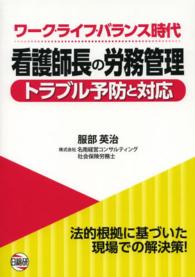- ホーム
- > 洋書
- > 英文書
- > History / World
Full Description
To this day, the commentaries on the Bible and Talmud written by the eleventh-century scholar known as Rashi remain unsurpassed. His influence on Jewish thinking was, and still is, significant. His commentary on the Pentateuch was the first Hebrew book to be printed, giving rise to hundreds of supercommentaries. Christian scholars, too, have relied heavily on his explanations of biblical texts. In this volume Avraham Grossman presents a masterly survey of the social and cultural background to Rashi's work and pulls together the strands of information available on his life, his personality, his reputation during his lifetime, and his influence as a teacher. He discusses each of his main commentaries in turn, including such aspects as his sources, his interpretative method, his innovations, and his style and language. Attention is also given to his halakhic monographs, responsa, and liturgical poems. Despite Rashi's importance as a scholar and the vast literature published about him, two central questions remain essentially unanswered: what was Rashi's world-view, and was he a conservative or a revolutionary?Professor Grossman considers these points at length, and his in-depth analysis of Rashi's world-view - particularly his understanding of Jewish uniqueness, Jewish values, and Jewish society - leads to conclusions that are likely to stimulate much debate.
Contents
Translator's Note Note on Transliteration 1 The Social and Cultural Background of Rashi's Work The Jews' Political, Economic, and Social Status The Troyes Community and the Jewish Centre in Champagne The Twelfth-Century Renaissance The Jews' Social Ties to their Surroundings Jewish--Christian Religious Polemics 2 Rashi: A Biographical Sketch Rashi's Life Character Traits Standing and Fame 3 Rashi's Beit Midrash Growth of the Beit Midrash 'The Great Rabbi' Library and Sources 4 Literary Works: Commentary on the Torah The Text of Rashi's Commentary on the Torah Rashi's Interpretative Method Rashi's Profound Affection for Midrash General Characteristics of the Commentary 5 Literary Works: Commentaries on the Prophets and the Writings (Nakh) Language, Grammar, and References to Daily Life Style of the Commentaries General Characteristics of the Commentaries 6 Literary Works: Commentary on the Talmud For Whom Did Rashi Write his Commentary on the Talmud? Extent of the Commentary Interpretative Characteristics Connections with Other Interpretative Traditions Versions and Editions of the Commentary Changes and Contradictions Halakhic Rulings in Rashi's Commentary on the Talmud 7 Literary Works: Rulings, Responsa, Liturgical Poems, and Commentaries on Liturgical Poems Rulings Responsa Liturgical Poems Commentaries on Liturgical Poems 8 Rashi's World-View: The Uniqueness of the Jewish People Methodological Introduction The Election of Israel The Land of Israel Miracles Exile and Redemption The Nations of the World 9 Rashi's World-View: Values Torah and Torah Study Reasons for the Commandments Prayer Truth and Humility Human Dignity Peace and Factionalism 10 Rashi's World-View: Society Scholars Community Leaders Forced and Voluntary Converts from Judaism The Status of Women and their Place in Society and the Family 11 Postscript: Between Innovation and Conservatism Innovation and Mission How Did Rashi Attain his Historic Status? Bibliography Index






